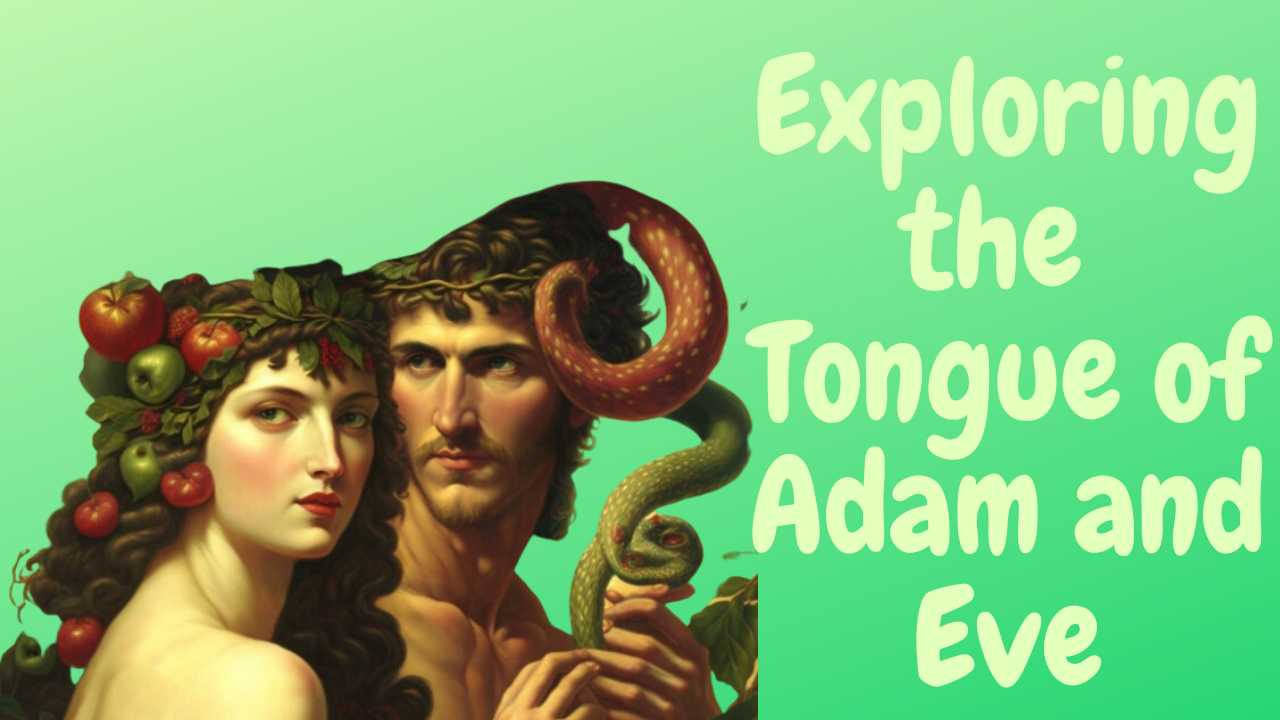What language did Adam and Eve speak? This intriguing question has captivated the minds of scholars, theologians, and linguists for centuries. As we delve into the depths of this linguistic enigma, we will explore historical theories, biblical perspectives, linguistic evidence, anthropological insights, and cultural interpretations to uncover the language that shaped the dawn of human communication.
From the Tower of Babel narrative to the latest linguistic reconstructions, our journey will unravel the complexities surrounding the language spoken by our primordial ancestors. Join us as we embark on an enlightening exploration of the origins of human language and the enduring legacy of Adam and Eve.
Historical Theories

Numerous historical theories have attempted to identify the language spoken by Adam and Eve, the first humans according to Abrahamic religions. These theories draw upon various sources, including religious texts, linguistic analysis, and archaeological findings.
One prominent theory suggests that Adam and Eve spoke a “primordial language,” a single, original language from which all other languages evolved. This theory is often associated with the biblical narrative of the Tower of Babel, in which God confounds the languages of humanity as punishment for their hubris.
Linguistic Evidence
Linguists have studied the similarities and differences among languages to identify potential remnants of a primordial language. Some researchers have proposed that certain grammatical structures or vocabulary items may be shared across multiple languages, suggesting a common origin.
Archaeological Evidence
Archaeologists have also sought evidence of a primordial language in ancient inscriptions and artifacts. Some scholars have argued that certain symbols or markings found in prehistoric sites may represent a proto-language or a precursor to later writing systems.
Significance of the Tower of Babel Narrative
The Tower of Babel narrative plays a significant role in historical theories about the language of Adam and Eve. In this story, God confuses the languages of humanity as punishment for their attempt to build a tower reaching heaven. Some scholars interpret this as a symbolic representation of the fragmentation of a single, original language into multiple tongues.
Biblical Perspectives
The Bible provides several passages that shed light on the language spoken by Adam and Eve. In Genesis 2:19-20, it is mentioned that God brought the animals to Adam to see what he would name them, and whatever Adam called each living creature, that was its name.
This suggests that Adam possessed the ability to communicate with the animals, implying a shared language between them.
Universal Language
The concept of a “universal language” is prevalent in the biblical context. In Genesis 11:1, it is stated that “the whole earth was of one language and one speech.” This implies that before the event known as the “confusion of tongues,” all of humanity spoke a single, common language.
Confusion of Tongues
The biblical account of the “confusion of tongues” in Genesis 11:1-9 describes an event where God intervened to confound the languages of the people who were attempting to build a tower reaching to the heavens. As a result of this divine intervention, the people were scattered across the earth, and their languages were diversified.
This event is often seen as the explanation for the diversity of human languages.
Linguistic Evidence
Linguistic evidence is one approach to speculating about the language spoken by Adam and Eve. This involves examining the diversity of languages today and attempting to reconstruct extinct languages to trace their origins.
Methods for Reconstructing Extinct Languages
Reconstructing extinct languages is a complex process that involves several methods:
- Comparative linguistics:Compares related languages to identify similarities and differences, which can provide clues about their common ancestor.
- Internal reconstruction:Examines a single language to identify patterns and changes over time, which can reveal information about its earlier stages.
- Lexicostatistics:Uses the rate of vocabulary replacement to estimate the time depth of language divergence.
Limitations and Challenges
Using linguistic evidence to determine the language spoken by Adam and Eve has several limitations and challenges:
- Incomplete data:The historical record of languages is incomplete, especially for ancient periods.
- Assumptions about language evolution:Methods for reconstructing extinct languages rely on assumptions about how languages change over time.
- Multiple interpretations:Linguistic evidence can often be interpreted in multiple ways, making it difficult to draw definitive conclusions.
Anthropological Perspectives
/Adam-and-Eve-GettyImages-171163783-584988e13df78ca8d5572385.jpg)
Anthropological theories provide valuable insights into the evolution of human language and its connection to environmental and cultural factors. These perspectives can shed light on the language spoken by Adam and Eve, offering a broader understanding of its origins and development.
Environmental and Cultural Influences
Anthropologists emphasize the profound impact of the environment and culture on language development. Different environmental conditions, such as geographical isolation or exposure to diverse ecosystems, can shape the vocabulary and grammar of a language. Cultural practices, social interactions, and belief systems also influence language, as they provide a framework for expressing ideas and experiences.
Implications for the Language of Adam and Eve, What language did adam and eve speak
Applying anthropological theories to the question of the language spoken by Adam and Eve, we can consider the environmental and cultural context of their existence. The Garden of Eden, as described in the biblical narrative, was a unique and isolated environment, which may have influenced the development of a distinct language.
Additionally, the cultural and cognitive abilities of Adam and Eve would have played a role in shaping the complexity and sophistication of their language.
Cultural Interpretations

Cultural interpretations and myths surrounding the language spoken by Adam and Eve have been shaped by religion, folklore, and literature. These interpretations have influenced the understanding of human language and its origins.
Religious Perspectives
Many religions believe that the language spoken by Adam and Eve was a divine language given to them by God. In the Christian tradition, this language is often referred to as “Adam’s language” or “the language of Paradise.” It is believed to have been a perfect language, capable of expressing all human thought and emotion.
Folklore and Literature
Folklore and literature often depict Adam and Eve speaking a language that is different from the languages spoken by humans today. In some stories, this language is said to be a secret language that only Adam and Eve could understand.
In other stories, it is said to be a language that has been lost to time.
Influence on the Understanding of Human Language
These cultural interpretations have influenced the understanding of human language in several ways. First, they have led to the belief that human language is a gift from God. Second, they have contributed to the idea that there is a single, original language from which all other languages have descended.
Third, they have shaped the way that we think about the relationship between language and thought.
Conclusion

The quest to determine the language spoken by Adam and Eve remains an ongoing endeavor, with new discoveries and theories emerging constantly. While definitive answers may elude us, the pursuit of knowledge and the exploration of linguistic possibilities continue to captivate our imaginations.
Through this multifaceted examination, we have gained a deeper appreciation for the intricate tapestry of human language and the enduring power of storytelling.
Q&A: What Language Did Adam And Eve Speak
Did Adam and Eve speak a single language?
According to biblical tradition, Adam and Eve initially spoke a universal language. However, the Tower of Babel narrative suggests that this language was later fragmented into multiple tongues.
What linguistic methods are used to reconstruct extinct languages?
Linguists employ comparative linguistics, studying similarities and differences between related languages, to reconstruct extinct languages. They also utilize archaeological evidence and written records to supplement their analysis.
How do cultural interpretations influence our understanding of the language spoken by Adam and Eve?
Cultural myths, folklore, and religious beliefs have shaped diverse interpretations of the language spoken by Adam and Eve, reflecting the cultural and historical contexts in which these stories have been passed down.